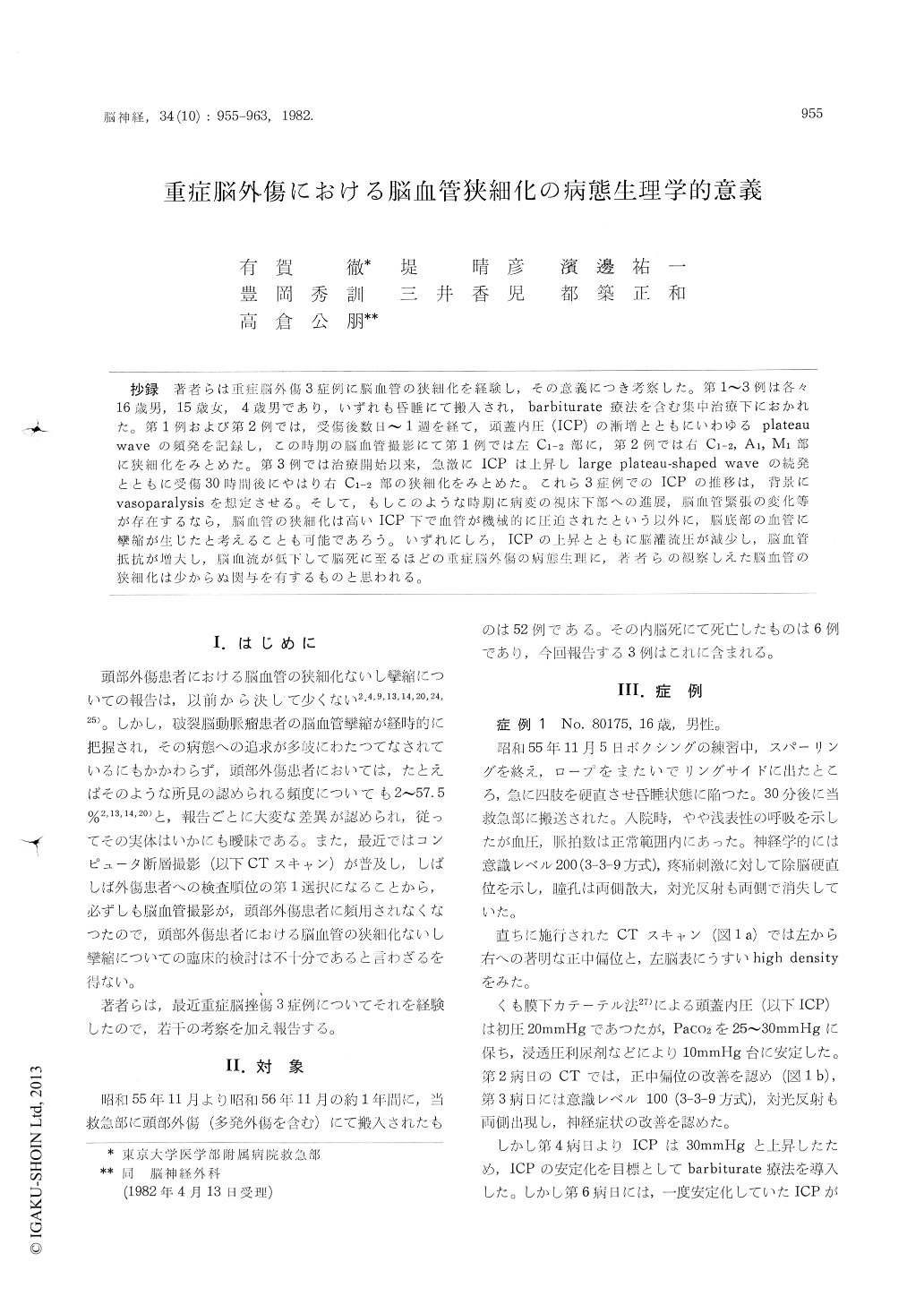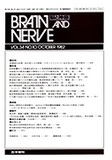Japanese
English
- 有料閲覧
- Abstract 文献概要
- 1ページ目 Look Inside
抄録 著者らは重症脳外傷3症例に脳血管の狭細化を経験し,その意義につき考察した。第1〜3例は各々16歳男,15歳女,4歳男であり,いずれも昏睡にて搬入され,barbiturate療法を含む集中治療下におかれた。第1例および第2例では,受傷後数日〜1週を経て,頭蓋内圧(ICP)の漸増とともにいわゆるplateauwaveの頻発を記録し,この時期の脳血管撮影にて第1例では左C1-2部に,第2例では右C1-2,A1,M1部に狭細化をみとめた。第3例では治療開始以来,急激にICPは上昇しlarge plateau-shaped waveの続発とともに受傷30時間後にやはり右C1-2部の狭細化をみとめた。これら3症例でのICPの推移は,背景にvasoparalysisを想定させる。そして,もしこのような時期に病変の視床下部への進展,脳血管緊張の変化等が存在するなら,脳血管の狭細化は高いICP下で血管が機械的に圧迫されたという以外に,脳底部の血管に攣縮が生じたと考えることも可能であろう。いずれにしろ,ICPの上昇とともに脳灌流圧が減少し,脳血管抵抗が増大し,脳血流が低下して脳死に至るほどの重症脳外傷の病態生理に,著者らの観察しえた脳血管の狭細化は少からぬ関与を有するものと思われる。
The authors report three cases of severe headinjury who demonstrated cerebrovascular narrow-ing angiographically, to be followed by brain death. They were two males of sixteen years and four years of age, and a fifteen year old female, who were among six brain deaths of fifth-two head injury patients transported and hospitalized in Emergency Department, University of Tokyo Hospital, during the period from Nov. 1, 1970 to Nov. 31, 1971.
The three patients were all comatose and showed decerebrated posture and mydriatic pupils with no light reflex on admission and were placed under the intensive care with circulatory monitoring using Swan-Ganz catheter, mechanical ventilation, intracranial pressure monitoring and so on. Intracranial pressure was measured with the subarachnoid catheter method and tried in each case to be controlled not only with osmotic diuretics, steroids and hyper-ventilation but allso with large dose of pentobarbital (NembutalR).
In the sixteen year old male (Case No. 80175) suffering from cerebral contusion and very thin subdural hematoma on the left hemisphere plateau-like waves appeared in intracranial pressure wave recordings on the 6th day after traumaa. The computed tomography on the same day showed extensive low density in the left hemisphere. The left carotid angiography on the 10th day demon-strated the vascular narrowing of left C1-2 portion, which was not evident on the 6th day. The base-line of intracranial pressure getting higher, large plateau-shaped waves came to be observed in spite of continued barbiturate therapy. The patient died in 16 days after trauma.
The fifteen year old female (Case No. 81142) was diagnosed as cerebral contusion, whose computed tomography on admission demonstrated the low density lesion and high density spot in its center in the right temporal lobe. In this patient pentobarbital treatment was discontinued on the 7th day because her intracranial pressure was well controlled and no clinical exacerbation was proved either angiographically or on the serial computed tomographies. But as the serum concentration of pentobarbital fell down to lower level, small plateau-shaped waves appeared in the intracranial pressure wave recordings. At the same time the cerebrovascular narrowing of the right A1, M1 and C1-2 portion was verified on the 9th day. Thereafter large plateau-shaped waves appeared and cerebral death followed.
In the four year old boy (Case No. 81159) with right frontal and skull base fractures and cerebral contusion especially in the right frontal lobe large plateau-shaped waves were recorded frequently since intracranial pressure monitoring was begunafter admission. The next day right carotid angio-graphy demonstrated the evidence of decrease in cerebral blood flow and the vascular narrowing of the right C1-2 portion which had not been recognized on the carotid angiography performed before.
The autopsy findings (except for that of No. 81142 not permitted) showed nothing particular suggesting cerebrovascular stenosis, direct mecha-nical injury or else which would be responsible for the angiographical decrease in vascular dia-meter.
There have been many studies and reports on traumatic cerebrovascular narrowing or spasm but few, if any, discussed about the correlation between the angiographical findings experienced as above and the intracranial pressure wave forms recorded simultaneously. Such cerebrovascular narrowing as was observed in these patients might suggest vascular compression by cerebral swelling or vasospasm. The latter has been believed to be caused by traumatic subarachnoid hemorrhage or by direct mechanical irritation of cerebral vessels. These hitherto mentioned possibilities could not be denied as causal factors in these cases, for all of the patients suffered from severe cerebral contusion with subarachnoid bleeding and resultedin cerebral circulatory arrest accompanying cere-bral swelling. But if the plateau waves observed during each patient's intracranial pressure monitor-ing are to indicate increase in cerebral blood volume and undoubtedly cerebral vasoparalysis, it is possible for the now dysfunctioning fragile autoregulation mechanism to induce vasospasm for the purpose of remitting increased intracranial pressure and decreasing cerebral blood volume, just as possible excessive autoregulation can induce vasospasm in crises of hypertensive encephalopa-thy. And besides the hypothalamic dysfunction, which was suggested to have occured as diabetes insipidus complicated all the cases but the last might induce vasospasm because it was possible that the direct neural connections between the hypothalamus and the adjacent arteries of the Willis might transmit vasoconstrictive impulses to the intracranial arterial tree.
Cerebrovascular narrowing or spasm surely contributes to the ischemic brain damage in head injury patients and whether the brain death is impending or not, it must play a significant role in the severe cerebral contusion which is encoun-tering with decreased cerebral perfusion pressure and increased cerebrovascular resistance.

Copyright © 1982, Igaku-Shoin Ltd. All rights reserved.


